- Joined
- Oct 9, 2007
- Messages
- 47,308 (7.52/day)
- Location
- Hyderabad, India
| System Name | RBMK-1000 |
|---|---|
| Processor | AMD Ryzen 7 5700G |
| Motherboard | ASUS ROG Strix B450-E Gaming |
| Cooling | DeepCool Gammax L240 V2 |
| Memory | 2x 8GB G.Skill Sniper X |
| Video Card(s) | Palit GeForce RTX 2080 SUPER GameRock |
| Storage | Western Digital Black NVMe 512GB |
| Display(s) | BenQ 1440p 60 Hz 27-inch |
| Case | Corsair Carbide 100R |
| Audio Device(s) | ASUS SupremeFX S1220A |
| Power Supply | Cooler Master MWE Gold 650W |
| Mouse | ASUS ROG Strix Impact |
| Keyboard | Gamdias Hermes E2 |
| Software | Windows 11 Pro |
Xigmatek made huge strides in the case design game this year at Computex. The pillarless left-corner has been a recurring theme with cases this year, but Xigmatek took things up a notch or two. Firstly, it incorporated the seamless pillarless design element, where two separate glass panels don't meet at the pillarless corner creating a glass seam, but rather a single glass panel curves around the edge. Secondly, some of its case designs have clear glass top-panels. The Pano series is a great place to start our coverage. The Pano and Pano Arctic, are black and white trims of the baseline Pano case, with its seamless-pillarless design. You still get a panoramic view of your build, but the top panel metal, with a 3x 120 mm fan/radiator mount.
The vertically partitioned case sees the right compartment end just before the side-facing fan-vents, which are recessed, so even with a thick radiator and fans, nothing gets in the way of a long graphics card. The left compartment has at least 10 cm of crawl space, because the PSU is mounted sideways. This means ample room for motherboards with backside connectivity. The Pano Ultra is 25% larger in volume than the Pano, and has the same layout, except the top panel is now glass, and the bottom panel is designed such that a radiator installation there wouldn't interference with an add-on card installed in the last slot of the motherboard—so there's a compartment down there, you can install a few 3.5-inch drives if you don't have a radiator.
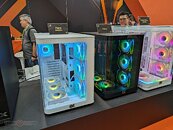
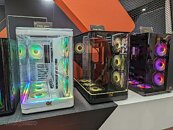
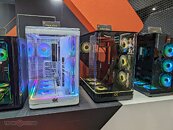
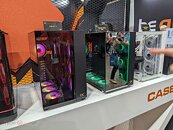
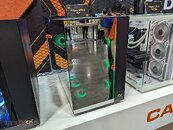
The Aqua V and Aqua Ultra Air features a similar layout to the Pano series, except the pillarless front-left corner isn't seamless. The series progresses just like the Pano—the Aqua V has a metal top panel. The Aqua Ultra has a glass top.
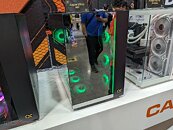
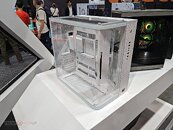
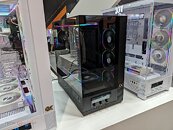
The Vision is an interesting case, which has glass on three sides, but implemented differently than on the Pano Ultra. It has glass to the front and left-side, as well as on top, and that entire edge of the case lacks pillars. A trigonal joint keeps the three panels aligned. The case is partitioned both vertically (with a crawl-space behind the motherboard tray) and horizontally, with its bottom compartment having the PSU bay oriented conventionally, a few drive bays, and an elaborate front-panel with an integrated fan-controller, lighting controller, with a display that puts out information pulled from ACPI. The left side has another segment of the front I/O, which includes a 20 Gbps-capable type-C, and a couple of type-A, besides a 4-pole headset jack.
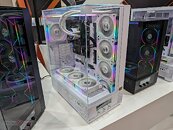
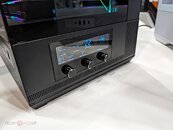
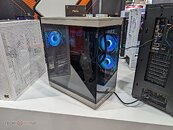
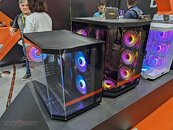
The Xigmatek Meta is a Micro-ATX tower that appears to be a scaled down version of the Aqua V, though retaining its essential design element of pillarless front-left corner. The Cubi II takes inspiration from the HYTE Y70—a 5-sided design, where the front-left corner is a side.
View at TechPowerUp Main Site
The vertically partitioned case sees the right compartment end just before the side-facing fan-vents, which are recessed, so even with a thick radiator and fans, nothing gets in the way of a long graphics card. The left compartment has at least 10 cm of crawl space, because the PSU is mounted sideways. This means ample room for motherboards with backside connectivity. The Pano Ultra is 25% larger in volume than the Pano, and has the same layout, except the top panel is now glass, and the bottom panel is designed such that a radiator installation there wouldn't interference with an add-on card installed in the last slot of the motherboard—so there's a compartment down there, you can install a few 3.5-inch drives if you don't have a radiator.





The Aqua V and Aqua Ultra Air features a similar layout to the Pano series, except the pillarless front-left corner isn't seamless. The series progresses just like the Pano—the Aqua V has a metal top panel. The Aqua Ultra has a glass top.



The Vision is an interesting case, which has glass on three sides, but implemented differently than on the Pano Ultra. It has glass to the front and left-side, as well as on top, and that entire edge of the case lacks pillars. A trigonal joint keeps the three panels aligned. The case is partitioned both vertically (with a crawl-space behind the motherboard tray) and horizontally, with its bottom compartment having the PSU bay oriented conventionally, a few drive bays, and an elaborate front-panel with an integrated fan-controller, lighting controller, with a display that puts out information pulled from ACPI. The left side has another segment of the front I/O, which includes a 20 Gbps-capable type-C, and a couple of type-A, besides a 4-pole headset jack.




The Xigmatek Meta is a Micro-ATX tower that appears to be a scaled down version of the Aqua V, though retaining its essential design element of pillarless front-left corner. The Cubi II takes inspiration from the HYTE Y70—a 5-sided design, where the front-left corner is a side.
View at TechPowerUp Main Site




